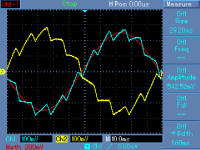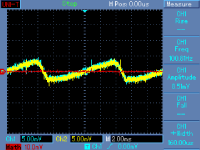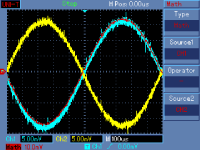Demian, Ed, Richard -
have you tried susceptibility of audio amplifiers to AM modulated or FM modulated high frequency carrier, with Hewlett-Packard AM/FM modulation generator or similar instrumentation.
Yes,
I think I have shown my AC line noise generator here. It is a relay connected to buzz.
I have a decent assortment of RF gear up to 1 GHz. I am planning on adding a better signal generator as they seem to be dropping cost.
As you likely know bipolar junction transistors have the most problems. Of course there are a number of IC's that measure great for distortion and noise, but in the next upgrade will include another pin for tuning voltage so you can at least pick the noise source!
We just shipped a control room and are finishing cleaning up. I have to mill a few boxes for a referee microphone switch, then I can go back to finishing my article on power supplies which has a bit on noise control.
ES
Hi Ed,
thanks for your reply.
BTW, there is one circuit topology of the power amplifier that is excellent in suppression of power rails supply noise, pls see attached image. Output is the red line.
thanks for your reply.
BTW, there is one circuit topology of the power amplifier that is excellent in suppression of power rails supply noise, pls see attached image. Output is the red line.
Attachments
Last edited:
I have done quit a lot of work on power line noise and commercially designed ac line filters for retail sale. I have shown here that most all of our electrical and electronic equipment puts out a wide spectrum of noise onto the line. PC's, wall wort supplies, TV's, digital products... everything.
AM... yes. you can measure the audio/music modulation created by power amps' current draw on the ac line.
Each products needs to have a line filter between it and the ac line. As for power amps, I dont know what will prevent AM of the line voltage.... the bigger the amp the bigger the problem created.... but a good volt regulator with filtering/isolation helps a lot.
Of course, it is not a problem if you dont know it exists.
Long afterwards, D. Self has also shown that THD of amp increased with extranious freqs on the power line getting thru to the circuit in typical power supply design. It is probably worse in a real home invironment than his tests as e have all sorts of things on the ac lines within the home which create a very wide range of interference frequencies to deal with... which audio by and large does not deal with or does so inadequately.
Thx-RNMarsh
AM... yes. you can measure the audio/music modulation created by power amps' current draw on the ac line.
Each products needs to have a line filter between it and the ac line. As for power amps, I dont know what will prevent AM of the line voltage.... the bigger the amp the bigger the problem created.... but a good volt regulator with filtering/isolation helps a lot.
Of course, it is not a problem if you dont know it exists.
Long afterwards, D. Self has also shown that THD of amp increased with extranious freqs on the power line getting thru to the circuit in typical power supply design. It is probably worse in a real home invironment than his tests as e have all sorts of things on the ac lines within the home which create a very wide range of interference frequencies to deal with... which audio by and large does not deal with or does so inadequately.
Thx-RNMarsh
Last edited:
Hi from Edmond Stuart; he is asking:
https://www.facebook.com/photo.php?fbid=526944357341171
Code:
Has John Curl built this 'portable' high-end system?https://www.facebook.com/photo.php?fbid=526944357341171
An externally hosted image should be here but it was not working when we last tested it.
I have 4 similar products plus a few others to measure harmonics with --> Not counting an A-P (sys one/dual domain), scopes and assorted meters and bridges, plug-ins:
I have virtually no use for that excess of dedicated hardware anymore, compared with the free software and good 24/192 IO devices now available the lack of flexibility of these things is just too frustrating.
The flat delay through the chain would be simple to correct for. Frequency and associated phase response would require more active correction. It could be done analog or digitally.
I would make a 20 minute track so theres lots of variations. Then use something like a DAW to invert and add. The residual should highlight any differences. Read about using audio diffmaker here FLAC vs WAV Part 2 Final Results - Blogs - Computer Audiophile to get an idea of the comprison phase. Audio diffmaker may be a very good tool for this. Audio DiffMaker
Jeez give me a break, wouldn't running diff on the two output streams work just as well?
He only has to use some free “rusted tube socket” simulators
And welcome back
George
such a way?
Becoming a tradition of some sort ?
Armageddon - Funny Russian Astronaut - YouTube (0:50)
Dick, thanks to your offer to measure, and Dave, I agree with what you write. I was referring to FT, not FFT, my oversight, but the point I still want to put across is the following.
To go back the the Kaiser Wilhelm sine: in order to generate one it is probably best to bang some components together. The reason is that in order to work, the width of the spike should be smaller than the sampling frequency of the FFT system allows, i.e. should fall outside the nyquest frequency. This excludes generation of a digital waveform.
My reasoned guess is that once generated, the Kaiser Wilhelm sine will not show other harmonics than the ones inherent to the system with an ordinary sine. In stead, it will raise the noise floor. The spike has the same spectrum as let's say a spark, so will uniformly contribute to the noise floor.
So, the direction I am thinking in is not so much to measure with noise, but to look at the noise in function of a signal and find out what the signal related contributants are. This could identify Pavels random peaks, for example.
Edit: I just realize this is the same as looking at distortion residual so I am probably barking at the wrong tree here.
To go back the the Kaiser Wilhelm sine: in order to generate one it is probably best to bang some components together. The reason is that in order to work, the width of the spike should be smaller than the sampling frequency of the FFT system allows, i.e. should fall outside the nyquest frequency. This excludes generation of a digital waveform.
My reasoned guess is that once generated, the Kaiser Wilhelm sine will not show other harmonics than the ones inherent to the system with an ordinary sine. In stead, it will raise the noise floor. The spike has the same spectrum as let's say a spark, so will uniformly contribute to the noise floor.
So, the direction I am thinking in is not so much to measure with noise, but to look at the noise in function of a signal and find out what the signal related contributants are. This could identify Pavels random peaks, for example.
Edit: I just realize this is the same as looking at distortion residual so I am probably barking at the wrong tree here.
Last edited:
Hi Scott; can you fix your modern software such a way?
It was them damn Rosenbergs who leaked that bit of US technology to the Soviets. Nearly cost us the cold war.
se
It was them damn Rosenbergs who leaked that bit of US technology to the Soviets. Nearly cost us the cold war.
Soviet space ships were made using sledgehammers, and it is true. But centralized planning was much less effective than free business that existed in USA then; they could not plan properly right places to bang, from the top, also plans were always corrected by government clerks, so Soviet Union had collapsed: not enough of sledgehammers, banging in wrong places. Reports were fake: sometimes there were reported more bangs per second than hammers allow, and so on. Usual problems of excessively complex systems with distorted feedback paths.
Last edited:
Jeez give me a break, wouldn't running diff on the two output streams work just as well?[/
As long as you could guarantee the two samples were taken at exactly the same time.
Soviet space ships were made using sledgehammers, and it is true. But centralized planning was much less effective than free business that existed in USA then; they could not plan properly right places to bang, from the top, also plans were always corrected by government clerks, so Soviet Union had collapsed: not enough of sledgehammers, banging in wrong places. Reports were fake: sometimes there were reported more bangs per second than hammers allow, and so on. Usual problems of excessively complex systems with distorted feedback paths.
se
Jeez give me a break, wouldn't running diff on the two output streams work just as well?[/
As long as you could guarantee the two samples were taken at exactly the same time.
FLAC and .wav of same file what other choice is there? Wav is uncompressed and FLAC is losslessly compressed same data. Entropy of music allows ~3X or so lossless compression.
The reason is that in order to work, the width of the spike should be smaller than the sampling frequency of the FFT system allows, i.e. should fall outside the nyquest frequency. This excludes generation of a digital waveform.
Yes but then you lose the point of testing the usability of the FFT for the job at hand. That is if you want to quantify the effect of a train of 1V, 1ns pulses on top of an audio signal you don't use a 96k FFT.
- Status
- Not open for further replies.
- Home
- Member Areas
- The Lounge
- John Curl's Blowtorch preamplifier part II


